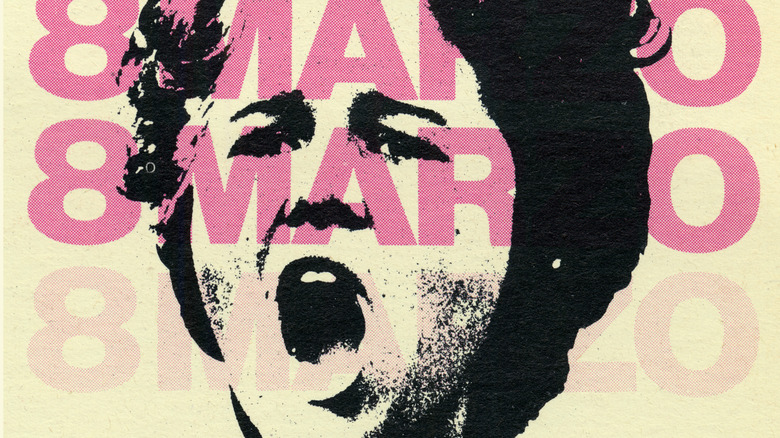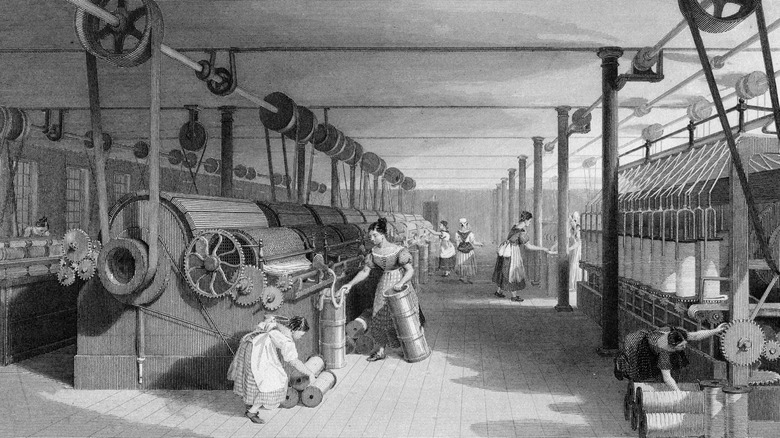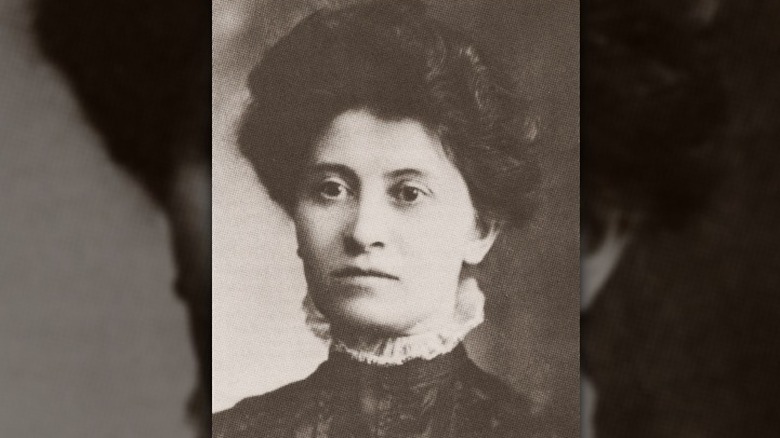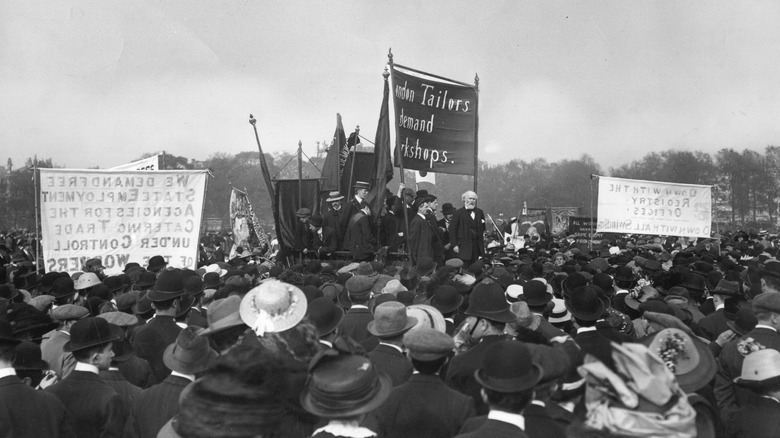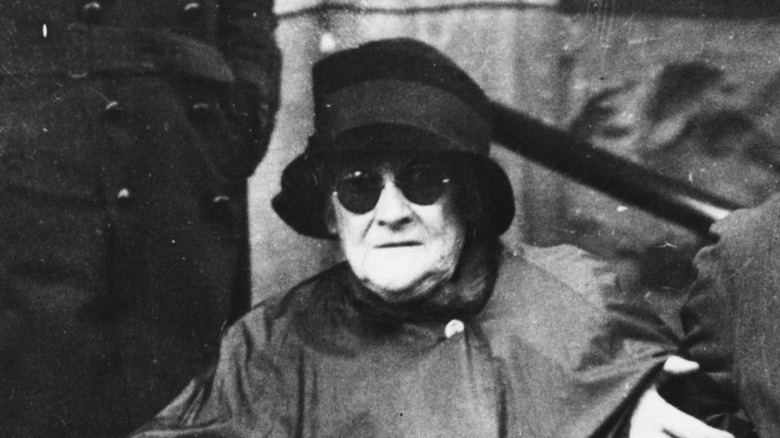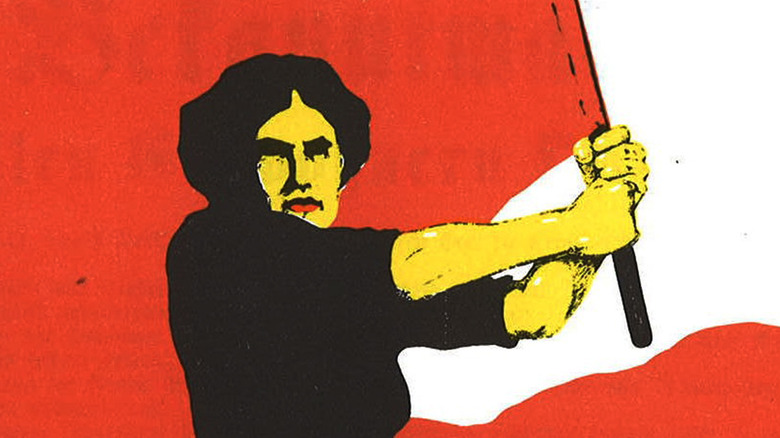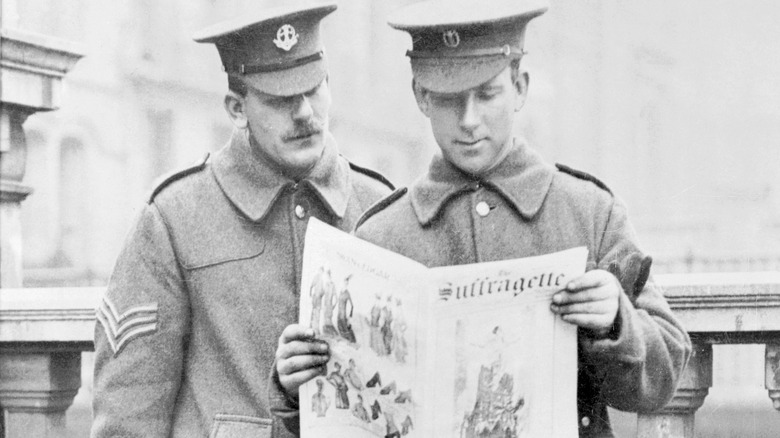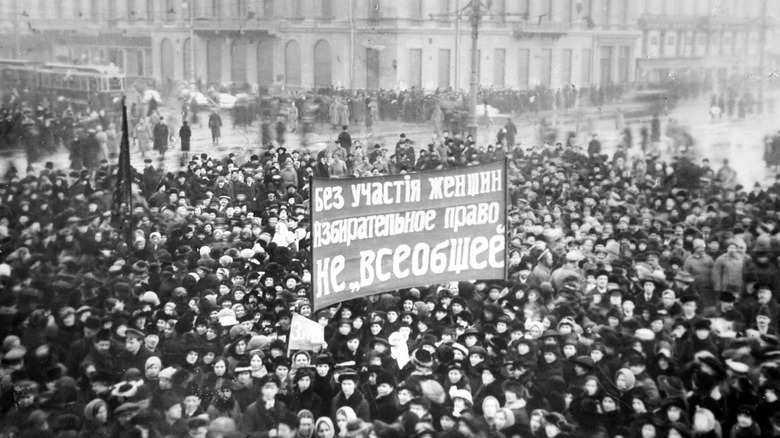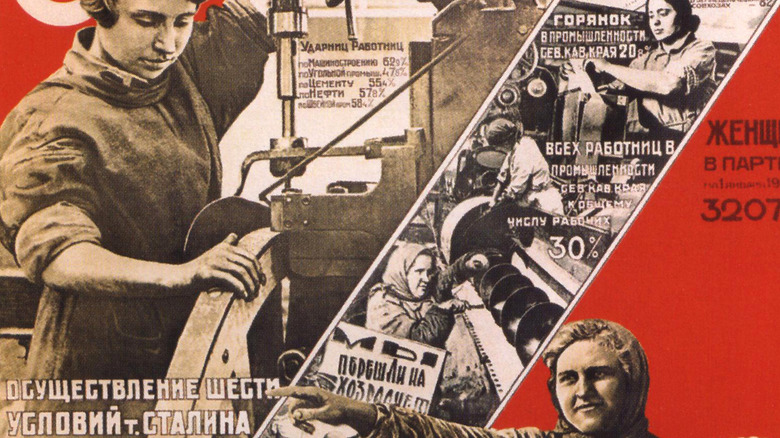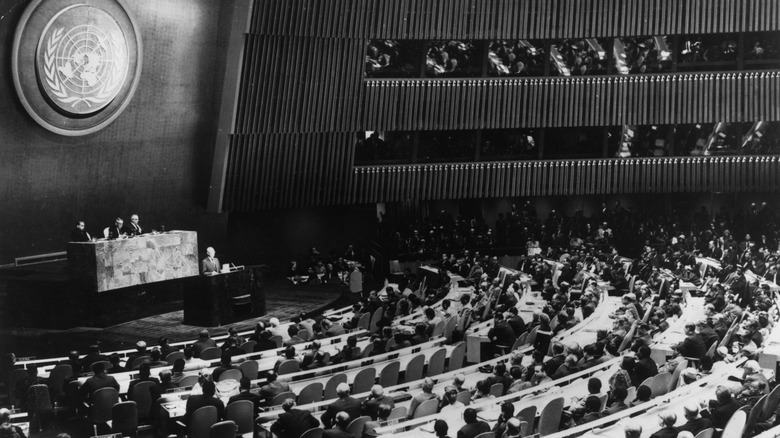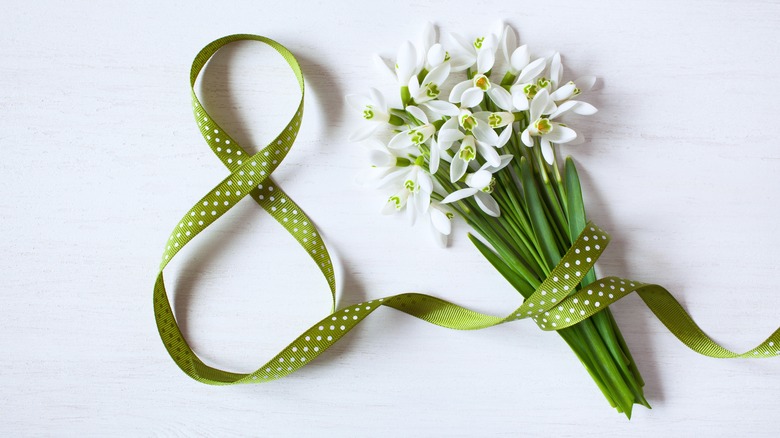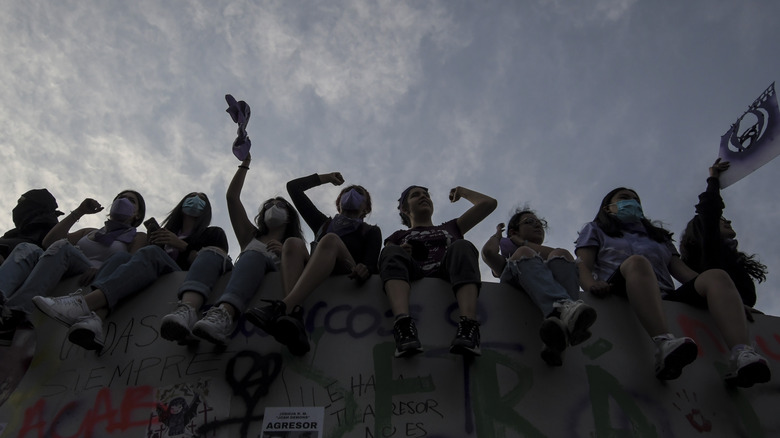The Untold Truth Of International Women's Day
Modern International Women's Day is a celebration of women's achievements, but its origins are far more radical in nature. The true story of this global celebration involves labor strikes, unions, and even a revolution.
In recent years, the holiday has become increasingly commercialized, with brands marketing jewelry, perfume, and makeup. But the holiday is intrinsically tied to workers' rights, feminism, and socialism. As noted by History, research has shown that some of the misinformation around the origin of the holiday was intentionally created in order to distance International Women's Day celebrations from their socialist ties.
While today March 8 is often used to honor women and their contributions to society, it was once a day for marching in the streets and demanding equal rights. Many activists still view International Women's Day this way: There are still protests, and many use the holiday as a time to discuss the future of women around the world.
There is a founding myth
In the United States, there is a commonly accepted story about the origins of International Women's Day. According to the National Archives, the story began in 1857 when a group of textile workers protested their long hours and low wages. In 1908, women workers marched again, both to protest the conditions in the sweatshops that employed them and to demand the right to vote. The National Archives gives the date for both of these events as March 8. As described in "Feminist Studies" by women's studies professor Claire Moses, there is a more brutal version of this story in which the protest of 1857 was violently shut down by the New York City police. In the ensuing chaos, some women were stampeded.
But historical evidence has shown that the majority of this is untrue. In reality, there likely was no 1857 event and the March 8 date is from an entirely different protest. The myth of the first International Women's Day has been pervasive and that likely was not an accident.
The creator of International Women's Day was a radical activist
In 1874, Theresa Malkiel was born in Russia. Her family was Jewish and faced persecution, so in 1891 they came to the United States. Writing in "American Jewish History," Sally M. Miller notes that Malkiel would start her new life as a sweatshop worker in New York City, but would soon become a powerful labor organizer — the one we have to thank for an international day celebrating women.
As described by The Washington Post, women at garment factories were required to work 18 hours a day in dangerous working conditions, which barely provided them with enough income to afford a bed in a crowded tenement. Malkiel saw the horrors of life as a single immigrant woman working in the city's sweatshops, and she became a socialist, supporting workers' rights through unions. She supported the rights of all women and particularly poor, Black, and immigrant women. In 1909, she proposed the first National Woman's Day (which would later become "women's"). As noted by historian Temma Kaplan in "Feminist Studies," American socialists set the first International Woman's Day on February 23 because it was the final Sunday of the month, and that way working women would be able to attend.
Holidays were a form of political activism
A holiday may seem like an unusual form of political activism in the modern world, but in the late 19th century, socialist and anarchist groups frequently put together festivals and events that would engage people and draw them into the cause. Presumably, more people could attend and be active members of society if these events were hosted on non-working days. As described by historian Temma Kaplan in "Feminist Studies," a popular date for these celebrations was July 14, in honor of the beginning of the French Revolution celebrated on Bastille Day. The date became popular with international revolutionaries interested in promoting their own causes.
Others built on existing traditional celebrations. As detailed by NPR, May Day was also adopted as a day to promote workers' rights. In 19th century Chicago, the American Federation of Labor set May 1 as the date for a massive strike to demand eight-hour work days (which at the time was approximately half of the typical shift). Like these other revolutionary holidays, Woman's Day was designed to unite the community and promote common goals, according to Kaplan.
International Women's Day blended socialism and feminism
An annual International Woman's Day was first proposed at the International Women's Conference before the Socialist Second International in Copenhagen in 1910. As described by Origins from Ohio State University, it was designed to promote rights for women — particularly the right to vote. The women behind the proposition were Luise Zietz and Clara Zetkin, two influential German socialists.
The blending of socialism and feminism was a radical idea. Zietz and Zetkin argued that implementing socialism would bring about gender equality. Feminists were often viewed as wealthy, selfish reformers who only supported improving life for themselves and other women like them, leaving working-class women behind. But getting women the right to vote became a unifying goal for women across class barriers. Because if socialists wanted to keep working women supporting the cause, they would have to advocate for their right to vote.
Eventually, protests and revolutionary meetings spread across Europe as a part of International Women's Day. The tradition continued, and these annual events attracted socialist and feminist women alike.
The first celebrations were rallies for women's rights
The earliest International Women's Day events were political rallies promoting the rights of women, particularly in the labor force.
As described by historian Temma Kaplan in "Feminist Studies," the 1909 event was attended by approximately 2,000. They sang songs and listened to passionate speeches from women speakers, arguing for the right to vote. Author Charlotte Perkins Gilman spoke to the crowd, telling them that a "woman's duty is centered in her home and motherhood," but that "home should mean the whole country and not be confined to three or four rooms or a city or a state."
In Boston, feminist suffragettes and socialist organizers joined forces to host an event. The women were dressed in all white and carried a variety of political banners (the majority of which were socialist). In the end, there were too many attendees to fit into the hall they booked.
International Women's Day was anti-war
During New York City's International Woman's Day meeting in 1911, socialist activist Bertha Fraser suggested that women would be excellent voting citizens because they couldn't be in the military. At the time, a popular argument against women being allowed to vote was that "they cannot be soldiers," and as such, "when they get the ballot they will use it to make war impossible" (via "Feminist Studies").
With the outbreak of World War I, it would seem like social reform would risk taking a backseat. But International Woman's Day events continued every year. They debuted anti-war art, showing the impact of the violence on women and their children, who could not vote for the politicians who had taken them to war.
Socialist Clara Zetkin, one of the original proposers of International Woman's Day, gathered women from opposing sides of the war to protest the conflict in a massive demonstration on March 7, 1915. They wrote a manifesto, aimed at working-class women around the world, that urged them to take action against the war. According to the manifesto, the working class gained nothing from the war and was losing the most.
A March 8 event sparked the Russian Revolution
On March 8, 1917, working class Russian women held an International Women's Day protest. This event would be the catalyst for major change in Russia, according to The Guardian.
By this time, International Women's Day was an established holiday for socialists around the world. Tens of thousands of women gathered in the capital city of Petrograd. Their backgrounds varied, but many were peasants or textile workers. They carried revolutionary banners that said things like "Feed the children of the defenders of the motherland" and "Supplement the ration of soldiers' families, defenders of freedom and the people's peace." Soon, they were joined by men, and the protest grew. Eventually, more than 100,000 people marched in the streets demanding bread and peace. Although they were met with police forces, they persisted. And as stated by Origins of Ohio State University, the Tsar was forced to resign four days later.
It was an official communist holiday
In 1922, Vladimir Lenin officially declared March 8 International Women's Day in the Soviet Union. As stated by Origins by Ohio State University, the holiday was soon celebrated by communists internationally, particularly in China and Spain. In communist East Berlin, there were parades on March 8 until 1990, according to the BBC. But West Germany wouldn't celebrate the holiday — which they call "Frauentag" — at all until the 1970s in order to separate themselves from their communist neighbors.
In Soviet Russia, International Women's Day became a day for discussion of the achievements of women and their role in society, per Russia Beyond. Meetings were held in factories where women worked. After it became an official holiday, women were given the day off to celebrate. Traditionally, husbands would take on the chores that his wife was responsible for in the home for the day. Flowers were a common gift for women at the time.
The United Nations made it official
In 1975, the United Nations hosted its first conference focused entirely on issues women faced in Mexico. During that year, the UN celebrated International Women's Day for the first time, and two years later, the UN General Assembly would declare March 8 "United Nations Day for Women's Rights and International Peace."
This decision did not necessarily mean that the UN wanted to embrace the revolutionary origins of the holiday. As described by Origins of Ohio State University, International Women's Day had been a day for organizing, protesting, and discussing the future of women workers since its inception. But the UN described its version of the holiday as being a day to reflect on the progress that women had made and to "celebrate acts of courage and determination of ordinary women." Ever since, International Women's Day is celebrated by the UN through events with different annual themes, like the empowerment of women in rural communities.
International Women's Day is celebrated differently around the world
International Women's Day is now truly an international holiday, but it isn't celebrated the same way around the world.
Theresa Malkiel might have proposed an International Woman's Day in the U.S., but it wasn't until 1980 that the country made a version of the holiday official. Rather than calling the holiday by its name, the U.S. hosted National Women's History Week and Women's History Month in March of that year. As described by The Independent, the president makes an official proclamation about the achievements of American women, schools often focus on famous women throughout history, and city governments will sometimes host special events supporting women.
In Italy, it's traditional for people to purchase yellow flowers for the women in their lives. In China, women are typically given part of the day off. In England, events are hosted to promote women's equality and pro-women organizations raise money.
In Russia, International Women's Day remains an important holiday, but the way it is celebrated has changed significantly. As described by ABC News, men are encouraged to purchase gifts (particularly flowers, chocolate or champagne) for the women in their lives. There, it seems like the day has completely transformed to instead promote "old-fashioned visions of what women's roles should be," per ABC News.
It has become commercialized
International Women's Day has spread around the world, but for many, its meaning has changed. In addition to some conscious attempts to distance the modern holiday from its radical routes, it has been increasingly used as a marketing opportunity. Although the day was originally about bringing women together to improve their circumstances, recently, women are encouraged to buy things to celebrate their contributions to society.
Many have criticized corporations that use International Women's Day as an opportunity to market their products to women without any meaningful contribution to women's rights. As described by Vogue, one of the most common ways that businesses attempt to participate in International Women's Day is by selling shirts with feminist slogans on them. Typically this is better received by the public when proceeds from the sales are donated to charities that support women, but it can still appear hypocritical if the brand in question hasn't made tangible attempts to promote equality within their own company.
These token nods to the meaning of International Women's Day at least include some tie to the holiday's historical roots. In other parts of the world, some traditions focus more on gift giving than organizing for labor rights. Purchasing gifts associated with Valentine's Day has become a staple of many International Women's Day celebrations, per History. In China, International Women's Day has been a popular holiday for a long time, but it's more about shopping, fashion, and beauty in its modern form.
International Women's Day can still help women organize for a better future
Modern International Women's Day is not only a celebration of the achievements of women. Many activists use the holiday to discuss how far we are from true equality and what can be done about it.
In the 1970s, the Third World Women's Alliance — a revolutionary collective of women of color that fought against racism, sexism, capitalism, and imperialism — held International Women's Day celebrations that specifically honored working-class women of color. As described by The Washington Post, International Women's Day has been a useful tool for activists to discuss the intersection of racism, sexism, and class, while raising awareness about their fight for equality which is often left out of mainstream white feminism. As described by Stonewall, International Women's Day can also be an opportunity to celebrate the contributions of lesbian, bisexual, and transgender women, as well as to focus on the specific forms of discrimination and oppression they face.
At the United Nations, International Women's Day promotes gender equality while also connecting gender inequality to issues that concern women and girls around the world. For example, in 2022, the theme "Gender equality today for a sustainable tomorrow" was chosen to discuss how marginalized people around the planet are at the greatest risk from the climate crisis. It also honors women's contributions to sustainability and climate action.
